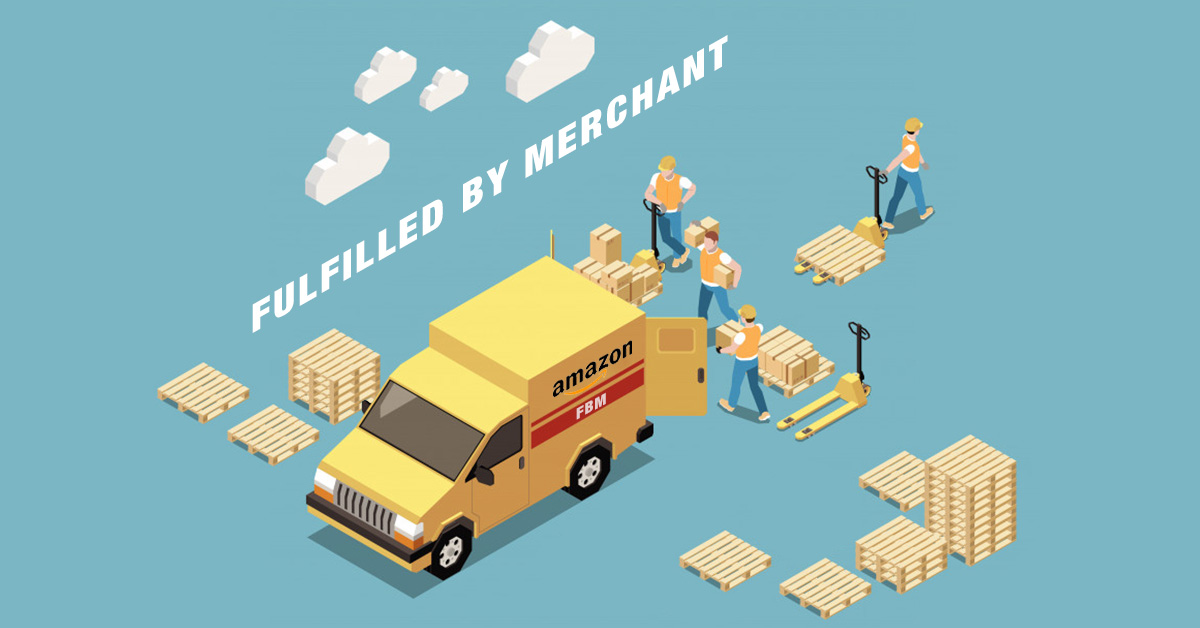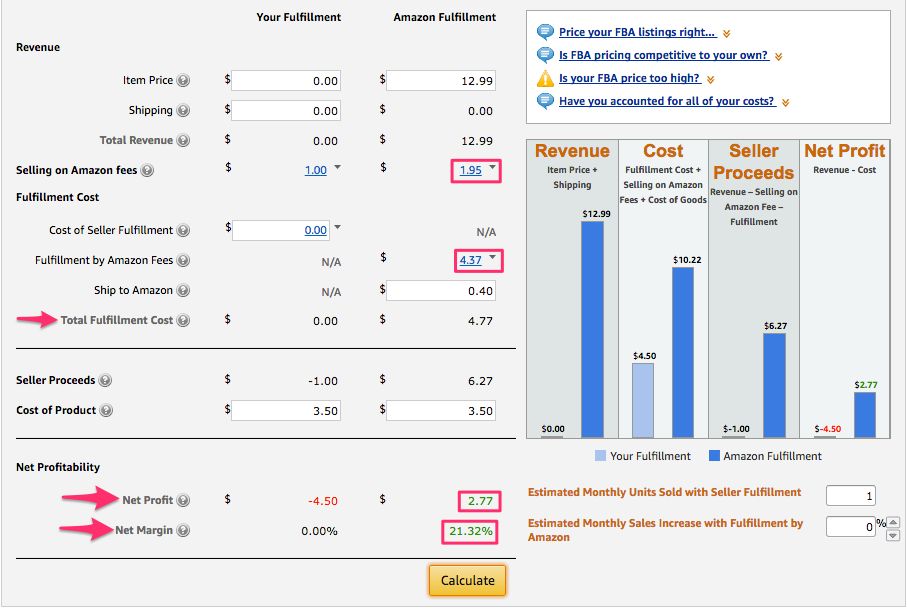9 December 2025
Top 7 Common Amazon FBA Mistakes by Sellers
TweetLinkedInShareEmailPrint 8 min read By Rick Wong Updated Dec 10, 2025 TL;DR What is the most costly...

If you’re a new Amazon Seller, looking to launch your business in 2021, then you might be wondering what’s the ideal business model for you. There are 2 main selling methods on Amazon – Fulfillment by Amazon, and Fulfillment by Merchant. So which is better? Here’s your guide to Amazon FBA vs. FBM.
Fulfillment by Amazon (FBA) means you list your products on Amazon, and send your inventory directly to Amazon’s warehouses. Amazon will store it in their fulfillment centers. Upon you receiving an order, they will pick, pack and ship it directly to the customer for you. Amazon will also manage any customer support inquiries on your behalf if you choose to use this method.
Fulfillment by Merchant (FBM) means you can list your products on Amazon but you will have to manage your own inventory. This includes storage, picking, packing, shipping and customer support themselves or through third-party logistics companies.
Regardless of your sales strategy… Whether it’s private label, wholesale, arbitrage, or dropshipping. Or whether your sales method on Amazon is limited to either FBA, FBM, or a mix of both. As a new seller, it’s difficult to decide which method to use. So in this article, we have laid out the pros and cons of each method for you.
Article Contents
FBA is a method that most existing sellers generally favor on Amazon. According to JungleScout statistics, 92% of sellers use Amazon FBA. That’s nearly all sellers on Amazon! It must be noted this does not mean Amazon FBA is the best method. There are still 34% of them that also use FBM to sell. Still, Amazon FBA is clearly a desirable sales method for Amazon sellers.

There are numerous advantages to using Amazon FBA. First and foremost, you don’t have to store, coordinate, package, or deliver your own products. You don’t have to handle returns or customer inquiries either. Not only this, but Amazon FBA sellers are automatically given Prime Shipping benefits. There are 112 million Prime subscribers in the US, so automatically being eligible for prime shipping is possibly the biggest benefit of Amazon FBA.
Another key advantage is that FBA products win the Buy Box almost all the time. Amazon decides which seller wins the Buy Box on fulfillment channels. Only the fastest and the most reliable sellers win the Buy Box. As an Amazon FBA seller, you are considered to have perfect scores across all these metrics. This is for FBA products, Amazon itself is in charge of fulfillment. They consider their own metrics to be perfect.
A lesser-known advantage is that FBA sellers have an edge when it comes to Amazon SEO. Performance data of sellers heavily implies that Amazon FBA products get higher positions in SERPs, simply because Amazon customers prefer to buy products fulfilled by Amazon. Fulfillment is a key factor that contributes to your Amazon SEO. While unconfirmed by Amazon, it is true that Amazon FBA products generally get more exposure.
If you want to focus on selling and not sourcing, and want Amazon as a part-time endeavor then Amazon FBA is for you. There is a truly vast amount of resources available on the internet on how to manage Amazon FBA stores, so the learning curve is not steep. Best of all, Amazon’s retail operations are open 24/7, so even when you’re asleep, your goods are shipped out and your orders keep running.
On the other hand, FBA does have its disadvantages. First of all, Amazon charges various small fees (more on that below). They are complicated and hard to understand. You have to cultivate a level of trust with Amazon and accept that you are getting fair prices if you want to use Amazon FBA. Moreover, you also must place your faith in Amazon warehouse staff and believe that they are handling your products with care.
The biggest disadvantage to FBA comes from Amazon itself. It is widely known that Amazon FBA Seller Support is extremely unhelpful in times of crisis and has trouble answering simple seller inquiries. Not to mention, Amazon changes its policies frequently, it will sometimes limit your SKUs, or mismeasure your products and overcharge you until you bring it to their attention. One example of an impactful policy change was Amazon stopping deliveries during the global COVID pandemic, forcing FBA sellers to stop accepting more orders whether they wanted to or not.
In addition, FBA sellers are subject to Amazon’s pricing structure, if the FBA fulfillment fees increase, you have to pay them.
While the convenience of FBA is undeniable, it’s a double-edged sword. If you face a worst case scenario where you have to recall defective products, it can take months to get those products delivered back to you simply because your inventory is spread between so many Amazon warehouses (even if its the same SKU) and commingled with other Amazon FBA seller’s products.
If you have not recently reviewed your Amazon numbers, it might be time to re-evaluate. Three fee changes that Amazon rolled-out in 2024–2025 can swing profitability by several dollars per unit and may thus affect which method optimal for your product mix.
Inbound placement service fee (FBA): As of 2024, FBA charges an inbound placement fee tied to how widely Amazon distributes your inventory. You can choose Amazon-optimized splits (more destinations, lower per-unit fee) or pay more to ship to fewer FCs; Amazon’s Revenue Calculator now reflects these fees so you can model which approach is likely most beneficial for you before you ship your inventory.
Low-inventory-level fee (FBA): Introduced in April 2024 for the US, this fee penalizes consistently low days-of-supply for standard-size FBA items. In practice, this incentivizes you to keep a healthy stock levels. As a result SKUs that are “profitable on paper” can actually be less profitable under FBA.
Returns processing fees: From June 2024 high-return-rate products in most categories incur extra FBA returns processing fees (with different handling for Apparel/Shoes). Thus for high-return categories, that extra cost can erase FBA’s operational convenience, particularly on low-margin SKUs.
What this means for you: Smaller, faster-moving items still often favor FBA, but oversized/slow movers, or products with high-return rates may no longer be that profitable under FBA and FBM (or a hybrid approach) may be ideal. Re-run your calculator assumptions with these fees included, or get in touch with us to discuss how optimize your operations.
About 43% of sellers on Amazon use FBM, implying a fairly even split between FBA and FBM. However, out of these, only 9% of sellers on Amazon exclusively use FBM as their only sales method. This doesn’t necessarily mean it is not a good sales method. There are many advantages to FBM that can cater to sellers who aim to sell a specific type of product and those who aim to be as consumer-facing as possible.

FBM is less popular than FBA by far but that’s not to say it doesn’t hold its share of advantages. Most sellers who choose FBM do so because their profit margins are higher, and they can price more competitively because not having to pay Amazon FBA fees cut down their costs. FBM is especially attractive for sellers who want to sell large-size, expensive products with a slow inventory turnover rate. FBM allows them to leverage the Amazon marketplace without having to pay the exorbitant storage and fulfillment fees Amazon charges for large-size products.
There is also the opportunity of lower logistics and handling fees if you have the right connections. Often if you ship larger quantities, FedEx or UPS will offer discounts. You can also have cheaper multi-fulfillment channels via 3PL warehouses, and can fulfill both online and offline orders using the same warehouse. Amazon FBA does not allow this, because what warehouse your SKUs are stored at is simply out of your control.
FBM is ideal for sellers who prefer control over their inventory & fulfillment processes and do not want to be subject to Amazon’s policies. It is also perfect for those who value the exclusivity of their brand, and want to focus heavily on direct customer service, to find out their customer’s pain points and build their brand further.
FBM has some major disadvantages compared to FBA, and most of it comes down to product visibility. The most worrisome disadvantage of FBM is that you do not automatically get the Seller Prime badge on your products, and instead need to qualify for it. The Seller Fulfilled Prime (SFP) program is the only way for FBM sellers to get prime benefits that 112 million Americans flock to, and unfortunately the requirements are tough.
In order to get SFP, sellers have to pass a trial period of 90 days, and do the following:
Not only do FBM sellers have to work harder to obtain Prime, FBM products also have less Buy Box power. SFP often increases the odds of FBM products winning the Buy Box, but it’s hard to maintain it when FBA offers always have an edge, simply because customers trust Amazon to fulfill their orders better. FBM also doesn’t get any SEO perks like FBA for the same reasons. The only true way to counter this is effective brand marketing, and a truly exceptional product that has enough ratings, the ideal pricing and SFP badge, that will attract customers to your FBM product rather than an FBA equivalent.
FBA and FBM both come with their respective benefits and limitations, so we recommend instead of focusing on statistics, or focusing on the intricacies of each program, new Amazon sellers should focus on what their business needs.
Here are several questions a new Amazon seller should ask themselves before they settle on FBM or FBA. They will serve as a guideline for what you want from your Amazon Business, and help lead you to a conclusion.
Some basic questions you absolutely need the answer to:

Other questions we recommend you think about seriously:
These are just a few of the numerous questions you’ll need to ask yourself before you settle on FBA or FBM (or both). They can indeed serve as a guideline for you to collect your thoughts, but at the end of the day you will need to sit down and crunch some numbers before you make a final decision. We recommend using Amazon’s FBA Revenue Calculator, it is a free tool available to all prospective Amazon Sellers. If you are not confident in financial aspects, you can also choose to hire a consultant or purchase software that will help you achieve the same.

We discussed a lot of pros and cons within this article, and it is definitely a lot of information to digest. To make it easier, we have compiled an overview for you, with a comparison table of Amazon FBA vs FBM. We’ve included the key differences and what each sales method is suited towards.

Armed with this comparison table and the list of questions we outlined in the previous section, you may find it easier to make the choice between FBA and FBM.
While it may sound very complex, using FBA and FBM often provides you “the best of both worlds”. Two common scenarios are running one ASIN under both models (a bit more complex), or picking the fulfillment model on a SKU level (so different approaches for different products). You can also use FBM as a buffer for peak sales periods.
Dual-offer under one ASIN. Keep your primary offer FBA for conversion and Prime, but maintain an FBM offer so you don’t go dark when FBA stock hits zero or an FC delay occurs. Pricing can auto-shift using rules to prioritize FBA when both offers are in stock.
Portfolio split. Send small/light and high-velocity SKUs to FBA; fulfill oversized/slow-turn SKUs via FBM or your 3PL.
Peak/Q4 contingency. Pre-position FBM buffer inventory before restock limits or space constraints bite. Hybrid sellers ride out disruptions with less revenue volatility.
FBA confers Prime automatically and thus automatically boosts the odds that you wind the Buy Box. That’s a key reason why FBA converts. Amazon’s public guidance frames FBA as a time-saver within Supply Chain by Amazon with “Prime eligibility” baked in.
FBM without SFP can still work—especially for heavy/oversize or custom SKUs—if you deliver fast and keep defect/cancel rates low. So, in a nutshell, you can pursue SFP when and if feasible, but otherwise FBA is the safer bet.
While it may sound very complex, using FBA and FBM often provides you “the best of both worlds”. Two common scenarios are running one ASIN under both models (a bit more complex), or picking the fulfillment model on a SKU level (so different approaches for different products). You can also use FBM as a buffer for peak sales periods.
Dual-offer under one ASIN. Keep your primary offer FBA for conversion and Prime, but maintain an FBM offer so you don’t go dark when FBA stock hits zero or an FC delay occurs. Pricing can auto-shift using rules to prioritize FBA when both offers are in stock.
Portfolio split. Send small/light and high-velocity SKUs to FBA; fulfill oversized/slow-turn SKUs via FBM or your 3PL.
Peak/Q4 contingency. Pre-position FBM buffer inventory before restock limits or space constraints bite. Hybrid sellers ride out disruptions with less revenue volatility.
FBA confers Prime automatically and thus automatically boosts the odds that you wind the Buy Box. That’s a key reason why FBA converts. Amazon’s public guidance frames FBA as a time-saver within Supply Chain by Amazon with “Prime eligibility” baked in.
FBM without SFP can still work—especially for heavy/oversize or custom SKUs—if you deliver fast and keep defect/cancel rates low. So, in a nutshell, you can pursue SFP when and if feasible, but otherwise FBA is the safer bet.
In summation, we believe there are benefits to both Amazon FBA and FBM, and that the final decision comes down to what you value in your business. However, for new sellers, a concrete answer to the Amazon FBA vs FBM debate is… go with FBA. Unless you have extensive expertise in logistics, we recommend Amazon FBA. In 2021, when the Amazon Marketplace is so saturated with competition, you will need every perk you can get. Amazon FBA gives you two automatically – Seller Prime and Buy Box.
Whether you choose FBA or FBM, your key focus even before launching your products will have to be Amazon Advertising. Amazon PPC management and optimization is the only true way to beat your competition in 2021, regardless of your sales method. We highly recommend looking into Amazon PPC Tools and Amazon PPC Management Software that will work for you.
We are SellerMetrics, our Amazon PPC Software helps Amazon sellers, brands, KDP Authors and agencies navigate Amazon Advertising PPC via bid automation, bulk manual bid changes, and analytics.
Fulfilled by Amazon (FBA) means Amazon stores, packs, and ships your products. Fulfilled by Merchant (FBM) means you handle storage, packaging, and shipping yourself or through a 3PL. FBA automates logistics, while FBM gives you full control.
It depends on your product size, turnover rate, and category. FBA can be cheaper for small, fast-moving products, but FBM often wins for bulky or slow-moving items because it avoids storage, placement, and returns processing fees.
Not always, but typically FBA listings have an advantage because of Prime eligibility and faster shipping. FBM sellers can still win the Buy Box if they offer competitive prices, fast shipping, and excellent seller metrics.
In 2025, three new or expanded fees impact profitability:
The Inbound Placement Service Fee for FBA shipments.
The Low-Inventory-Level Fee for consistently low stock.
The Returns Processing Fee for high-return categories.
Recalculate your margins using Amazon’s updated Revenue Calculator.
FBM works best for oversized or custom products, high-return categories, or brands that need to control packaging and branding. It’s also a good backup method during Q4 restock limits or when FBA warehouses experience delays.
Yes. Many sellers use a hybrid model — FBA for fast-moving SKUs and FBM for bulky or seasonal items. You can even list both offers under the same ASIN to avoid going out of stock when FBA inventory runs out.
Seller Fulfilled Prime allows FBM sellers to display the Prime badge if they meet strict performance and shipping standards. It’s ideal for high-performing FBM operations but can be challenging due to carrier and cut-off-time requirements.
To cut FBA expenses:
Ship to multiple FCs using lower-cost placement options.
Maintain healthy stock to avoid the low-inventory fee.
Optimize packaging to reduce dimensional weight.
Regularly audit listings to remove stranded inventory.